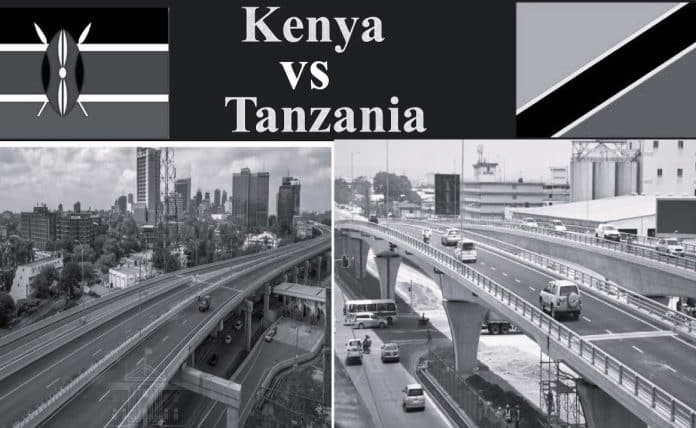The Ultimate Showdown: Unraveling the Rivalry between Kenya and Tanzania’s Economies
In the story of East Africa’s economic growth, two nations stand out: Kenya and Tanzania. These neighboring countries have been engaged in a fierce economic rivalry for years, each striving to outperform the other on the global stage. But what makes this competition truly fascinating is the divergent paths the Kenya vs Tanzania economy has taken to achieve their respective successes.
In this battle of Tanzania vs Kenya economy, the first competitor is Kenya. Kenya, known as the economic powerhouse of East Africa, has made impressive strides in sectors such as technology, finance, and tourism. Its vibrant startup scene and robust infrastructure have attracted investors from around the world, giving Kenya a competitive edge.
On the other hand, Tanzania has focused on developing its natural resources, such as gold, gas, and agriculture. This more cautious approach has allowed Tanzania to maintain stable economic growth in this ongoing Kenya vs Tanzania economic rivalry and attract long-term investment.
This article delves into the intricacies of the captivating Tanzania vs Kenya economic rivalry, exploring the unique strategies employed by each country and examining how they have shaped their economies. Through an analysis of key sectors, policies, and challenges, we will unravel the story behind Kenya and Tanzania’s economic showdown. Join us as we delve into the fascinating world of East Africa’s economic giants.
Historical background of the rivalry
The rivalry between the Kenyan and Tanzanian economies traces back to the pre-independence era. Both countries were under British colonial rule, but Kenya gained independence in 1963, a year before Tanzania. This early independence gave Kenya a head start in terms of economic development, as it had more time to establish its infrastructure and institutions.
When looking at the Tanzania vs Kenya economy, it’s necessary to also get some understanding of Tanzania’s economic past. Tanzania took a different approach from Kenya’s under the leadership of Julius Nyerere. Nyerere focused on socialist policies, advocating for self-reliance and rural development. This approach, known as Ujamaa, aimed to redistribute wealth and reduce income disparities. While it had its merits, it also slowed down Tanzania’s economic progress in comparison to Kenya.
Economic indicators of Kenya and Tanzania

When comparing the economic indicators of the Kenya vs Tanzania economy, it becomes clear that Kenya has been the more prosperous nation. Kenya’s gross domestic product (GDP) has consistently outperformed Tanzania’s over the years. In 2020, Kenya’s GDP was $95.5 billion, while Tanzania’s was $63.2 billion.
This disparity in the Tanzania vs Kenya economy can be attributed to several factors. Kenya’s diversified economy, with a strong focus on services such as finance, technology, and tourism, has contributed to its higher GDP. Additionally, Kenya’s strategic location as a regional hub for trade and investment has attracted international businesses, further boosting its economic growth.
When comparing the Kenya vs Tanzania economy in this light, it is clear that Tanzania, on the other hand, relies heavily on agriculture and natural resources, such as gold and gas. While these sectors have contributed to Tanzania’s economy, they are more susceptible to external shocks and price fluctuations, making the country’s GDP growth more volatile.
GDP comparison between Kenya and Tanzania
A closer look at the GDP growth rates of the Tanzania vs Kenya economy reveals interesting trends. Kenya has consistently maintained a higher GDP growth rate compared to Tanzania. For example, in 2020, Kenya’s GDP grew by 0.6%, while Tanzania’s grew by 2.0%.
This discrepancy can be attributed to Kenya’s more diversified economy and its focus on sectors with higher growth potential. Tanzania, on the other hand, has experienced slower but more stable growth due to its reliance on agriculture and natural resources. When comparing the Kenya vs Tanzania economy, Kenya’s higher growth rates may seem more impressive but Tanzania’s stability has its own advantages in terms of long-term sustainability.
Trade and investment between Kenya and Tanzania

Trade and investment play a crucial role in the rivalry between the Tanzania vs Kenya economies. Both countries have implemented various policies to attract foreign direct investment (FDI) and promote international trade.
Kenya’s strategic location and well-developed infrastructure have made it an attractive destination for businesses seeking to establish a presence in East Africa. Looking at the Kenya vs Tanzania economy, it is clear that Kenya has also implemented more business-friendly policies, such as tax incentives and streamlined regulatory processes, to encourage investment. As a result, Kenya has become a regional hub for multinational corporations and startups alike.
The Tanzania vs Kenya economy, on the other hand, has focused on creating an enabling environment for investment through policies that prioritize local content and value addition. The country has also made efforts to improve its business climate by reducing bureaucracy and simplifying regulatory processes. Tanzania’s approach has attracted investment in sectors such as mining, agriculture, and manufacturing.
Tourism industry comparison

The tourism industry is a significant contributor to the Kenya vs Tanzania economy. However, there are notable differences in how each country has developed this sector.
Kenya has positioned itself as a premier safari destination, offering world-class wildlife experiences in its national parks and reserves. The country has invested in infrastructure, such as luxury lodges and safari camps, to cater to high-end tourists. Additionally, when considering the Tanzania vs Kenya economy in terms of tourism, it’s worth noting that Kenya has also leveraged its coastal attractions, such as the pristine beaches of Mombasa and Lamu, to attract international visitors seeking a beach holiday.
Tanzania, on the other hand, has focused on its iconic tourist attractions, such as Mount Kilimanjaro and the Serengeti National Park. Looking at the Kenya vs Tanzania economy and coastal area developments, Tanzania has also developed its coastal areas, including Zanzibar and Mafia Island, as popular beach destinations. Tanzania’s commitment to wildlife conservation and its emphasis on sustainable tourism practices have helped attract tourists looking for authentic and eco-friendly experiences.
Agriculture and natural resources comparison
Agriculture and natural resources are vital sectors for the Tanzania vs Kenya economy. However, the approach taken by each country differs significantly.
Kenya has prioritized agricultural modernization and diversification to increase productivity and reduce dependence on rain-fed subsistence farming. The country has invested in irrigation schemes, improved seed varieties, and mechanization to boost agricultural production. Additionally, the Kenya vs Tanzania economy has embraced technology and innovation in agriculture, with the rise of agri-tech startups revolutionizing the sector.
Tanzania, on the other hand, has focused on smallholder farming and value addition. The country has implemented policies to support small-scale farmers, such as access to credit and extension services. The Tanzania vs Kenya economy has also invested in agro-processing industries to add value to its agricultural products, such as coffee, tea, and cashew nuts.
Infrastructure development in Kenya and Tanzania

Infrastructure development is a key driver of economic growth and competitiveness. Both Kenya vs Tanzania economy have made significant investments in this area, albeit with different priorities.
In the ongoing Tanzania vs Kenya economy showdown, it’s good to note some highlights. Kenya has focused on improving its transport infrastructure, including roads, railways, and ports, to facilitate trade and connectivity. The country’s flagship projects, such as the Standard Gauge Railway and the Lamu Port-South Sudan-Ethiopia Transport Corridor, have enhanced regional integration and positioned Kenya as a logistics hub.
Tanzania, on the other hand, has prioritized energy infrastructure, particularly in the gas sector. The discovery of significant natural gas reserves off the coast of Tanzania has led to the construction of liquefied natural gas (LNG) plants and the development of gas pipelines. These infrastructure projects aim to harness Tanzania’s natural resources for domestic consumption and export, thereby driving economic growth. Clearly, Kenya and Tanzania have different infrastructural plans, each with its own economic benefits.
Political factors affecting the rivalry
The Tanzania vs Kenya economic rivalry is not solely driven by economic factors; political dynamics also come into play. The political climate in each country can significantly influence the business environment and investment decisions.
The Kenya vs Tanzania economy has experienced a relatively stable political environment since its transition to multi-party democracy in the early 1990s. This stability has provided a conducive environment for economic growth and investor confidence. However, periodic political tensions and occasional instances of violence have raised concerns about the country’s political stability.
The Tanzania vs Kenya economy, under the leadership of President John Magufuli, has taken a more interventionist approach to governance. While Magufuli’s policies, such as cracking down on corruption and improving government efficiency, have been lauded by some, they have also raised questions about the country’s business climate and respect for democratic principles.
Conclusion: The future of the Kenya-Tanzania rivalry
The rivalry between Kenya and Tanzania’s economy is a fascinating tale of two nations with distinct economic strategies. Kenya’s focus on technology, finance, and tourism has propelled it to the status of East Africa’s economic powerhouse. Tanzania’s emphasis on natural resources and cautious approach to development has ensured stability and long-term growth.
As these two countries continue to compete on the global stage, it is essential to recognize that they also have much to gain from collaboration and cooperation. The future of the Tanzania vs Kenya economy rivalry lies not only in outperforming each other but also in leveraging their unique strengths to drive regional economic integration and prosperity.
In conclusion, the economic showdown between Kenya vs Tanzania economy is a testament to the diverse paths nations can take to achieve success. It is a tale of resilience, innovation, and resourcefulness. As we witness the ongoing rivalry between these East African giants, we can only anticipate further economic growth, competition, and collaboration in the years to come.
For more articles related to the Economy of Tanzania click here!

































